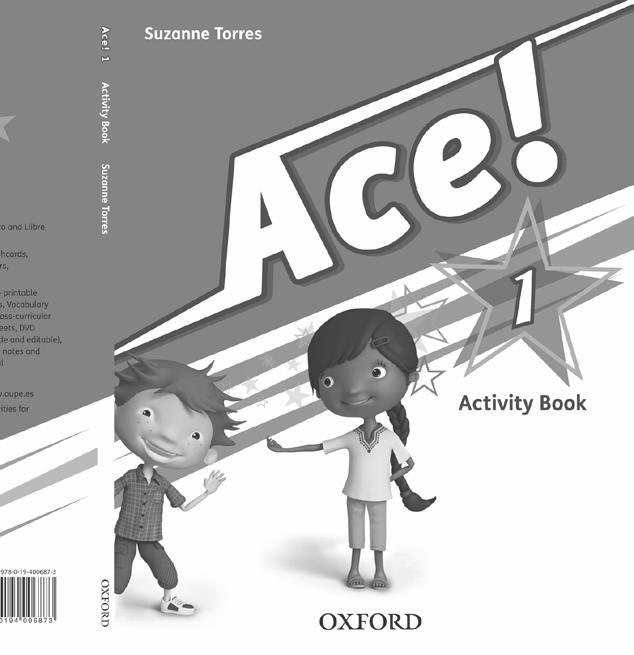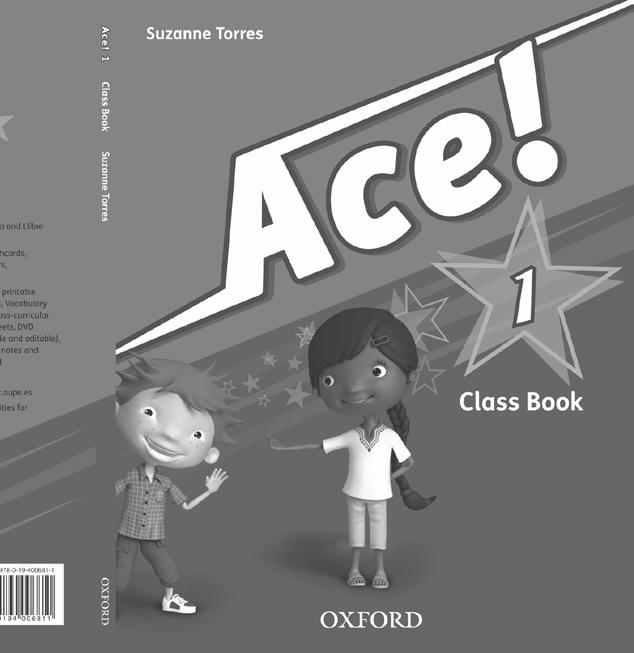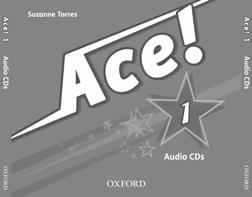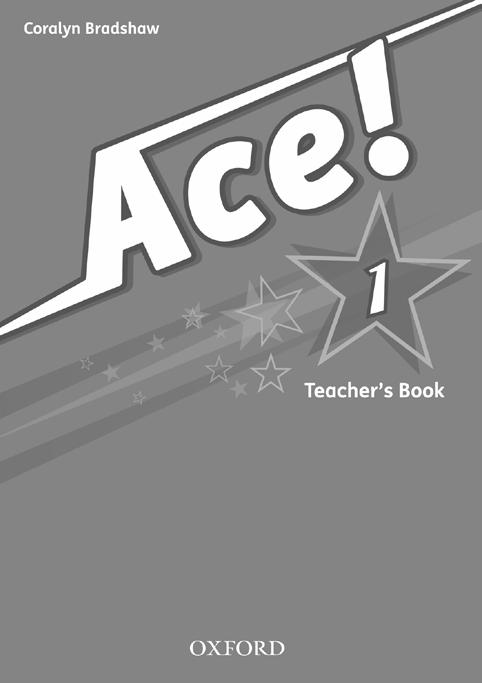This is a SEO version of Ace TB1 Cubierta.indd. Click here to view full version
« Previous Page Table of Contents Next Page »10 Components
Class Book
• a starter unit introducing Lola, Monty and Mr Sonic, their class teacher
• nine teaching units of ten lessons per unit providing the core material
• three pages of festival materials
• three revision stories featuring the course characters
• a clear syllabus summary showing the main language learned in each unit
• a songs CD with all the songs and chants from the course
Activity Book
• ten pages of activities per core unit, including a sticker activity; a Book Club feature; follow-up to the cross-curricular, phonics and cultural lessons; unit review and self-evaluation
• activity ideas for fast finishers at the bottom of each page
• follow-up to the revision stories
• follow-up to the festivals
• one cut-out per unit for pairwork activities
• 90 colour picture stickers of the core vocabulary
• 17 colour picture stickers of the festivals vocabulary
Teacher’s Book
• an introductory section including descriptions of the methodology and concept behind the course
• a full description of the syllabus
• an annotated Tour of a unit
• clear, succinct teaching notes for each lesson
• teaching notes for two optional lessons per unit (one DVD lesson and one cross-curricular lesson)
• optional extra activity ideas
• culture notes
• references to Key Competences
• full answer keys for Class Book and Activity Book activities
• tapescript for each lesson
• references to worksheets on the Teacher’s Resource CD-ROM
• an Ideas bank with games, activities and ideas for how to exploit the extra resources further (flashcards, posters, etc.)
• a list of the unit flashcards and wordcards
• useful classroom language and a wordlist
Audio CDs
• recording of all the songs, stories and listening activities including test listenings
Teacher’s Resource CD-ROM
• evaluation material
• nine unit tests, three term tests and one end-of-year test
• two worksheets to supplement the starter unit
• one story worksheet per unit
• two vocabulary and grammar worksheets per unit
• one cross-curricular worksheet per unit
• six festival worksheets (two per festival)












Finished? Finished? Find something red, something white and something blue in your classroom. Draw.
4
esson 2











6 7 8 9 10
mber the story. Colour and match. Say the colour.

2 3 4



31 Unit 1
Lesson Two
CB pages 6 and 7 and AB page 5
STORY AND MAIN LANGUAGE PRESENTATION
Lesson objectives
Describe the colour of objects using present simple. Understand a story.
Language
Core: purple, black, green, red, white, blue, brown, pink, yellow, orange, It’s (red)
Extra: today, art class, teacher, painting, butterfy, very good, handprint, wall, Oh, no! Look! My favourite colour is (blue). small, big, your, Oh, dear! sorry, It’s OK.
Materials
CD1 $ tracks 12, 14–15; Unit 1 flashcards Set 1 (colours); Unit 1 wordcards; Unit 1 storycards
Warmer $ 1•12
• Ask ten children to come to the front of the class, take a colour flashcard and stand in the order of the words in the song Blue, blue, blue in Lesson 1.
• Play the recording, encouraging the class to sing and the children with the cards to hold them up when they hear their word. The other children should point to the colours.
• Repeat with different groups of ten children. If you like, use the colour wordcards instead of the flashcards.
Lead-in
• With books closed, hold up the first storycard.
• Ask the children questions about the picture, e.g. Where are they? (at school) What’s this? (a painting) What colour is it? (red, yellow and blue). Who’s this? (the teacher).
Listen to the story with the storycards. $ 1•14
• Tell the children to look at the storycards and listen and enjoy the story.
• Play the recording, holding up the storycards one at a time.
• Point to key items in the pictures as they are mentioned in the recording.
Answer the storycard questions.
• Hold up the storycards one at a time and ask the children the questions on the back of each card to check comprehension of the story.
KEY COMPETENCE: Autonomy and personal initiative Stories help raising awareness of values and, often, developing strategies for confronting problems. Ask the children how Billy feels in Frame 5 of the story and how he copes with it in Frame 6. Ask why Mr Gnome apologises to the class at the end of the story and how the class react.
Class Book
1 Listen to the story. $ 1•14
• Tell the children to open their Class Books.
• Play the recording again, encouraging the children to listen and follow the story in their books.
2 Listen and say the number. $ 1•15
• Play the recording, pausing as indicated below.
• Ask the children to tell you the number of the story frame each phrase is from.
Transcript
Listen and say the number. Mr Gnome Oh, no! Look! A handprint! [Pause]
Daisy This is my paint. It’s yellow! [Pause]
Billy But my hand is small. This hand is big. [Pause]
Elf Look at my painting. It’s a butterfly. [Pause]
Mr Gnome Oh, dear! Sorry, children! [Pause]
Billy This is my paint. It’s blue! My favourite colour is blue. [Pause]
Billy Look at your hand, Mr Gnome! [Pause]
Sammy This is my paint. It’s red! [Pause]
AnsWErs
Frame 2 Frame 4 Frame 6 Frame 1 Frame 8 Frame 5 Frame 7 Frame 3
3 Act out the story.
• Divide the group into five large groups.
• Assign a role from the story to each group, e.g. one group is Mr Gnome, one group is the first elf, one group is Sammy, etc.
• Play the part of the narrator yourself and then encourage the groups to act out their part, saying the words from the story and doing appropriate actions of their choice.
• Then divide the class into smaller groups of five children to act out the story by themselves.
• Bring one or two groups to the front of the class to act out the story for the rest of the class.
Activity Book
1 remember the story. Colour and match. say the colours.
• Ask the children to open their Activity Books and look at the characters, paint pots and handprint.
• Tell the children to match the characters with the things that belong to them by drawing pencil lines.
• Check the activity by saying the name of the character and eliciting the colour of the paint or handprint.
AnsWErs
1 red 2 yellow 3 blue 4 blue
Book Club (Activities 2–4)
• Activity 2: Ask the children to colour the stars according to how much they enjoyed the story.
• Activity 3: Ask the children to circle their favourite character from the story.
• Activity 4: Ask the children to colour their favourite storycard. Display the storycards on the board in order and numbered to elicit their favourite card.
Further practice
Teacher’s Resource CD-Rom, Worksheet section, Unit 1, Story worksheet. Notes and answers on CD-Rom.


Class Book
Activity Book
Teacher’s Book


Audio CDs
This is a SEO version of Ace TB1 Cubierta.indd. Click here to view full version
« Previous Page Table of Contents Next Page »